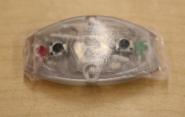From CEID Fellows, Security and Convenience in a Wearable Device

Members of the fourth cohort of the Yale School of Engineering & Applied Science's Summer Design Fellowship made their final presentations last week. The 12 students in residence at the Center for Engineering Innovation & Design comprised five teams, each working on a specific project for eight weeks. The Summer Design Fellowship is unique in that student teams are provided the resources to create hardware and software solutions for a specific problem, as opposed to working on previously established research projects. It is the only fellowship specifically designed to assist "makers" at Yale. Here is the third part of our article on the final presentations.
CONDUIT
The Conduit team - Tilman Bartelsmeyer ‘19, Hannah Knight ’19, and Patrick Aidan Brooks ’19 - is designing a wearable security alternative that contains multiple IDs. It would eliminate the hassle of finding your ID every time you enter a campus building, and double as a security device.
 Brooks said the team decided early on that they wanted to tackle an everyday problem of college students, and settled on how to eliminate the hassle of searching for an ID multiple times a day. They set their sights on creating one that can be worn on on the wrist, or as a necklace, or clipped onto a backpack.
Brooks said the team decided early on that they wanted to tackle an everyday problem of college students, and settled on how to eliminate the hassle of searching for an ID multiple times a day. They set their sights on creating one that can be worn on on the wrist, or as a necklace, or clipped onto a backpack.
“We have to take IDs out of our pockets, and sometimes they don’t read through our wallets,” he said. “Or they can be hidden in your bag and you have search and search and search. And if you can’t your ID, you can’t get in. We decided that what we want to make is a module, specifically for getting into buildings.”
As they were working on the device, the team members also decided that it could perform another service as an emergency alert system. The device user would punch in a series of buttons and the device would immediately connect to Yale emergency services via Bluetooth and send the user’s GPS location. “So it’s a silent way to alert emergency services if you’re in trouble of any sort,” Brooks said.
And unlike other personal alert systems, users would be more compelled to bring it with them when they leave their homes because it’s also needed for the everyday purpose of getting into campus buildings.
“The fact that it also functions as an ID and gets you into the places you need to be means that you’re going to be wearing this every day,” Knight said
The team has met with Yale Security about integrating the device with the university’s existing ID access system.
“One of the really important things about this is that we wanted to work within existing systems in order to minimize cost and delay,” Bartelsmeyer said. He added that the team will continue working on the device with Yale Security and with Jabil, a manufacturing services company.

